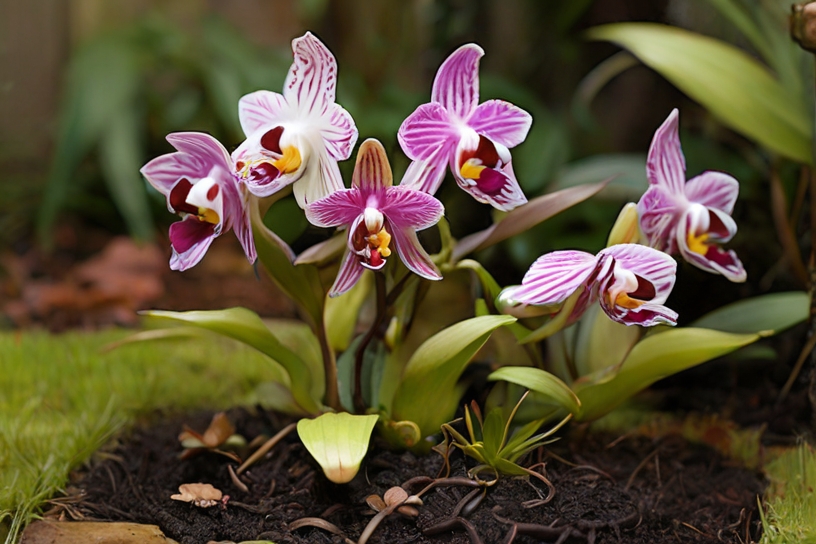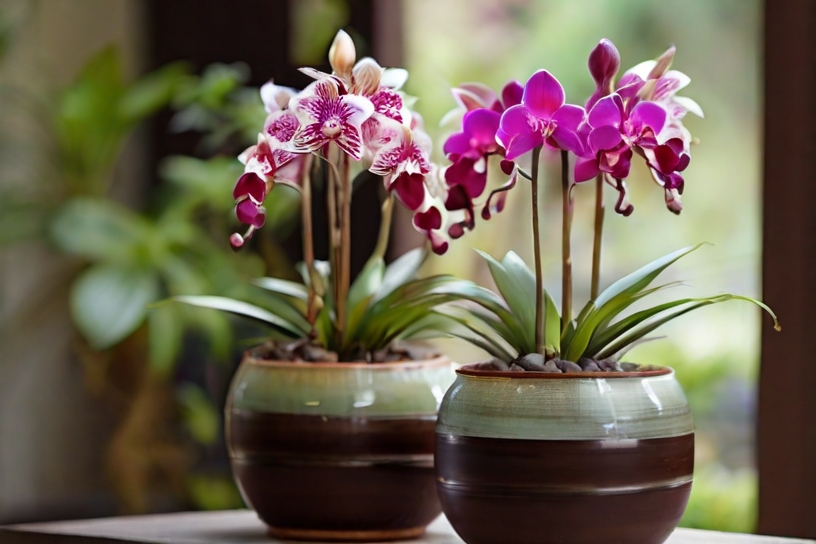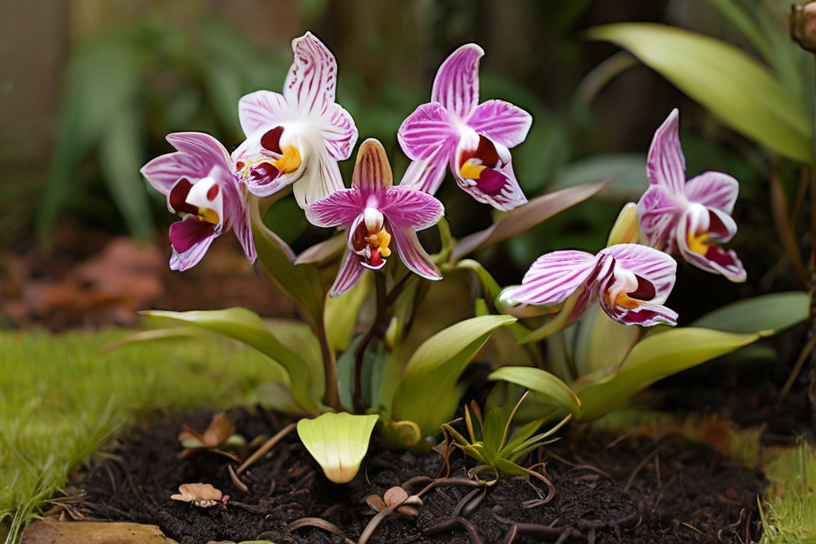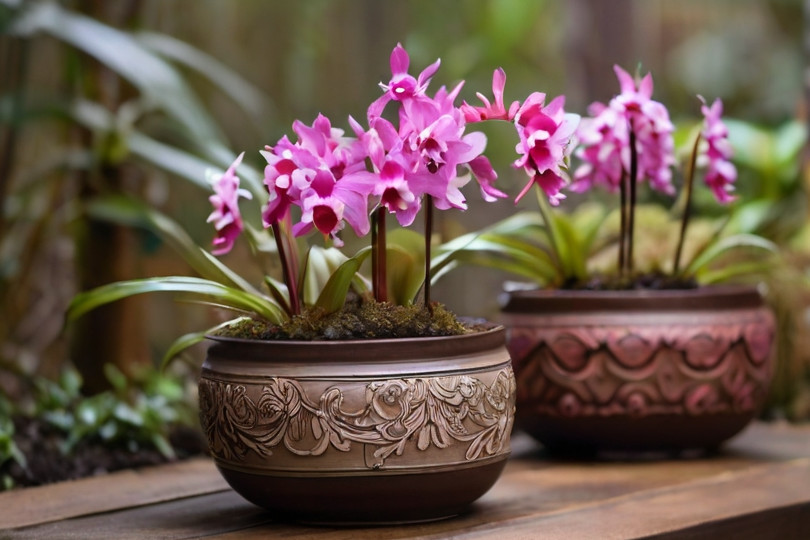Ground orchids, or terrestrial orchids, are diverse plants adapted to grow in the soil rather than in trees like their epiphytic counterparts. These unique orchids can be found in various habitats, from rainforests to grasslands, and they come in different sizes and colours. Ground orchids are relatively unknown in gardening despite their beauty and resilience. This blog highlights these fascinating plants, their characteristics and requirements, and how to successfully grow them in your garden.
Table of Contents
Different Varieties of Ground Orchids



Ground orchids come in various species, each with distinct characteristics and beauty. Let’s explore some popular varieties of ground orchids that can uplift your garden.
Bletilla: Also known as the Chinese ground orchid, Bletilla is a hardy and low-maintenance option. With vibrant flowers ranging from white and pink to deep purple, Bletilla adds colour to any garden.
Calanthe: Calanthe orchids are known for their elegant and enchanting flowers. They bloom in various colours, including white, pink, yellow, and red. Calanthe is an excellent choice for shady areas of your garden.
Paphiopedilum: As one of the most popular ground orchids, Paphiopedilum, or Lady Slipper orchids, is known for its unique pouch-like flowers. With a wide variety of colours and patterns, these orchids are a true delight to grow and behold.
Spathoglottis: Spathoglottis orchids are known for their showy and long-lasting flowers. Their vibrant colours, including yellow, pink, and purple, bring a tropical touch to any garden. Spathoglottis is well-suited for hot and humid climates.
When selecting a ground orchid variety, consider your climate, sunlight exposure, and personal preferences. Each variety has its own care requirements. Therefore, it’s important to research and understand the needs of the ground orchids you choose.
Tips for Successful Cultivation of Ground Orchids
Cultivating ground orchids in your garden can be a rewarding experience. These beautiful flowers can transform any space with their unique shapes and vibrant colours. To help them thrive, it’s crucial to understand their needs and provide the right care. In this guide, we’ll walk you through each step of ground orchid cultivation in simple terms, making it easy for even beginners to follow.
Selecting the Right Ground Orchids
When selecting ground orchids, matching the variety to your garden’s conditions is important. Here’s a breakdown of different orchid varieties and their specific needs:
Sunlight Requirements:
Full Sun Varieties: Dendrobium, Cymbidium, and Vanda orchids are known for thriving in full sun. They enjoy bright light and can tolerate direct sunlight, especially in cooler climates.
Partial Shade Varieties: Phalaenopsis and Paphiopedilum orchids prefer partial shade. These varieties do best in filtered light or a spot that receives a few hours of morning sun followed by afternoon shade.
Soil Type Preferences:
Orchids Preferring Loamy Soil: Oncidium and Miltonia varieties often thrive in a rich, loamy soil. This soil type provides a balance of nutrients and drainage they need.
Epiphytic Orchids Requiring Special Soil Mixes: Epiphytic varieties like Phalaenopsis and Dendrobium prefer a special orchid mix, which typically includes bark and other coarse materials to mimic their natural growing conditions on trees.
Moisture Level Needs:
Moisture-Loving Varieties: Paphiopedilum and Masdevallia orchids require consistently moist soil. They are less tolerant of dry conditions and benefit from regular watering.
Drought-Tolerant Varieties: Cattleya and Oncidium can withstand drier conditions better than other types. They prefer a ‘soak and dry’ method where the soil can dry out between waterings.
Take the time to research the needs of your selected orchids. This step is crucial for their long-term success.
Planting Your Orchids Correctly

Planting your orchids correctly is key to their growth. Depth and Soil Drainage are important considerations:
Planting Depth: Plant the tubers or rhizomes at the right depth. They should be covered but not buried too deeply.
Soil Quality: Ensure the soil is well-draining. Orchids don’t fare well in soggy conditions as it can cause root rot.
Balancing Water Needs
Watering ground orchids requires a delicate balance:
Avoid Overwatering: They shouldn’t be constantly wet.
Avoid Drought: They also can’t tolerate long periods of dryness.
Checking Soil: Water when the top inch of soil is dry. Ensure the water reaches the roots but not soak the leaves or flowers.
Feeding Your Orchids
Regular feeding is essential for robust orchids:
Type of Fertilizer: We recommend using a balanced orchid fertilizer.
Frequency: Typically, fertilize once every two weeks during the growing season, following the package instructions.
Avoid Overfeeding: Excessive fertilizer can damage the delicate roots.
Common Issues and Troubleshooting
While ground orchids can be a beautiful addition to any garden, it’s important to be aware of some common issues that may arise when growing these delicate plants. By understanding these challenges and knowing how to troubleshoot them, you can ensure the health and vitality of your ground orchids.
One common problem that gardeners may encounter is root rot. This can be caused by overwatering or poor drainage. Water your ground orchids sparingly to prevent root rot and provide them with well-draining soil. Suppose you notice any signs of yellow or brown roots. In that case, it’s important to immediately adjust your watering routine and repot the orchid if necessary.
Another issue that ground orchids may face is pest infestations. Aphids, mealybugs, and scale insects are common pests that can attack these plants. Regularly inspect your orchids for signs of pests, such as sticky residue or visible insects. If detected, you can use organic pest control methods or introduce beneficial insects to help eliminate the infestation.
In addition to pests and diseases, ground orchids may also experience nutrient deficiencies. These can manifest as yellowing leaves or stunted growth. To ensure that your orchids receive the necessary nutrients, it is important to fertilize them regularly with a balanced orchid fertilizer. However, be careful not to over-fertilize, as this can cause damage to the plants.
You can maintain a healthy, thriving ground orchid garden by proactively identifying and addressing these common issues.
Benefits of Growing Ground Orchids
Growing ground orchids in your garden can offer a multitude of benefits. One of the main advantages is their stunning beauty. Ground orchids can add colour and elegance to any landscape with their vibrant colours and unique blooms.
Another benefit of growing ground orchids is their ability to attract pollinators. Their flowers’ intricate shapes and fragrances are often irresistible to butterflies, bees, and other beneficial insects. By cultivating ground orchids, you are enhancing your garden’s visual appeal and creating a habitat that encourages biodiversity.
Furthermore, ground orchids are relatively easy to care for. Once established, they require minimal maintenance and can thrive in various soil conditions. This makes them an excellent choice for both experienced gardeners and beginners looking to add a touch of exotic flair to their outdoor spaces.
Conclusion and Final Thoughts
In conclusion, growing ground orchids can be a rewarding and enjoyable experience for any gardener. By being aware of the common challenges these plants may face, such as root rot, pest infestations, and nutrient deficiencies, you can take the necessary steps to prevent and address these issues. Remember to provide your ground orchids with well-draining soil, monitor for pests regularly, and fertilize them appropriately. The next section will delve deeper into the best practices for caring for and maintaining your ground orchids. We will discuss watering techniques, proper fertilization, and when and how to repot your orchids. Stay tuned for useful tips on keeping your ground orchids healthy and thriving in your garden.

